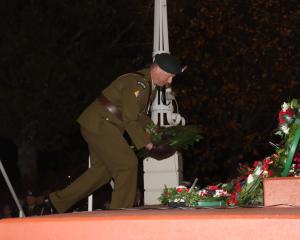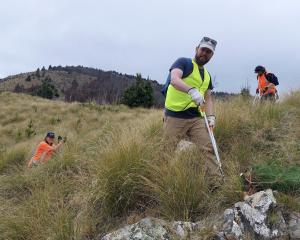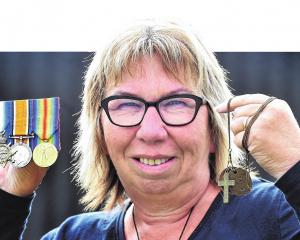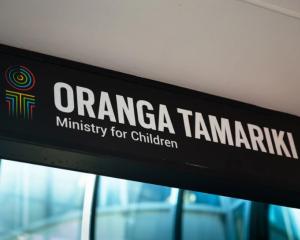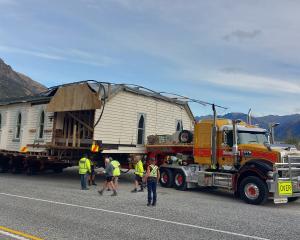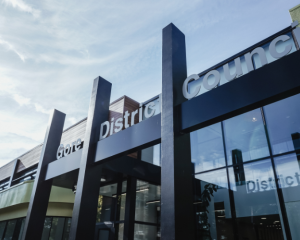For close to 50 years and from Invercargill to the United Kingdom and back again, Diana McLean kept treasured letters from Otto Frank with her. Now, she is amazed the letters are to be displayed at an exhibition in Sydney next year. Allison Beckham spoke to her about her unassuming aerogrammes which have attracted international attention.
Retired Invercargill doctor Diana McLean says it was the power of his daughter's story which prompted her to write to Otto Frank.
Aged 15 and living in Brisbane, Diana Munro, as she was then, had just read The Diary of Anne Frank - the poignant memoir of a Jewish family hiding from the German occupiers in Amsterdam, and the addendum which told of the deaths of Anne, her sister and her mother in a German concentration camp.
''I was a keen reader and it was a book which crossed my path. It was my first awareness of World War 2 in a real way.
''Thinking back, the power of the book was the writer was a young girl of approximately my own age, and I also at that stage was keeping a diary.
''So to think that she had similar feelings about the future and similar hopes and dreams meant [the book] had a pretty strong impact on me.''
Exactly what she said in the letter was ''in the realms of antiquity'', but she remembers telling him how the book had crystallised her desire to become a doctor and work with underprivileged children.
Months later, in November 1963, she arrived home from school one day to a surprise.
''My mum said, 'There's a letter for you, and I think you're going to be excited'.''
It was Otto Frank's reply, closely typed over a page and a-half of an aerogramme.
He said her letter had made a deep impression on him, especially knowing the book had ''changed her outlook on life'' and influenced her to pursue her desire to become a doctor.
''I particularly remember these sentences: 'Believe me, it is always only the individual who is able and willing to help in creating a better world, never the masses. If you carry out your intention to help children in one way or another you will do your share towards this goal'.''
Diana did not become a paediatrician.
But she did become a doctor, working at Kew Hospital in Invercargill (now Southland Hospital) on the wards and in the ultrasound department.
She met her obstetrician husband, Dr Norman McLean, while on a study elective at Kew in 1968. After completing her medical training in Brisbane, she accepted a job at Kew and married Norman in December 1970.
Not long before her marriage it occurred to her Otto Frank might like to know she had actually become a doctor so she wrote to him again, receiving a reply in June 1970.
In it, he said her news had given him ''great satisfaction''.
There is an added twist to the correspondence.
In October 1970, ''out of the blue'', Dr McLean received a letter from Canadian Elizabeth Bonnell McCuiag, who said she was writing a book about the importance of correspondence.
Mrs McCuiag had written to Otto Frank asking him to nominate a letter he had received which had meant a great deal to him personally, and he had told her about Diana achieving her ambition to become a doctor.
Dr McLean gave Mrs McCuiag permission to quote from her letters in the book, but never heard if it was published.
She said it was ''overwhelming'' to think Otto Frank had remembered her letters among the many thousands he had received.
In 2001, Dr McLean visited The Anne Frank House, which she said was moving.
But she said even more moving was visiting the former Auschwitz concentration camp in the mid-2000s and seeing Margot Frank's satchel included in a display.
It might have been that no-one outside Dr McLean's family ever got to learn of her letters.
But in January she received a phone call from Sydney Jewish Museum volunteer Anne Slade, who had tracked her down after some determined detective work.
While in Amsterdam visiting The Anne Frank House last year, Mrs Slade and her husband, Alan, who are both Jewish, were surprised to learn the letters sent to Otto from all over the world - including some from Australia - were carefully archived there.
They were even more surprised to discover museum touring exhibitions manager Levien Rouw was very keen to track down Otto's replies, in the hope recipients would give them to the museum or at least allow museum staff to copy them.
He learnt Mrs Slade volunteered in Sydney and put a proposal to her.
''He said, 'You're just the person to lead a special project for me'. He told me there were five Australian women known to have written to Otto, and asked me to try to find them and see if they still had their replies. We were a pilot project and if our project was successful it might become an international project,'' she told The Otago Daily Times last week from Sydney.
Armed with just the names of the Australian quintet, Mrs Slade began appealing for information via the media.
A woman in Australia heard a radio interview, recognised the name Diana Munro, remembered she had become a doctor and was living in New Zealand - in Dunedin, she thought - and Mrs Slade tracked her down through staff at Dunedin Hospital.
Mrs Slade said while Dr McLean's letters were the first to be ''found'', incredibly she had since located all five women in just three months.
Some had not kept their letters, but one woman had a large archive of Anne Frank-related material, including many letters from Otto and books with his signature.
''She formed a friendship with Otto and his second wife and kept in touch with them for many years.''
The letters, including Dr McLean's, will feature alongside an Anne Frank exhibition curated by Mr Rouw, which opens at the Sydney Jewish Museum next February.
Dr McLean said she had not yet decided whether to give her letters to The Anne Frank House but had already sent copies to Mrs Slade and planned to attend the exhibition.


